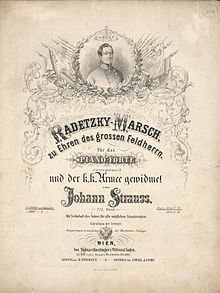The "Radetzky March", Op. 228, (German: Radetzkymarsch; pronounced [ʁaˈdɛtskiˌmaʁʃ] ⓘ) is a march composed by Johann Strauss (Senior) which was first performed on 31 August 1848 in Vienna to celebrate the victory of the Austrian Empire under Field Marshal Joseph Radetzky von Radetz over the Italian forces at the Battle of Custoza, during the First Italian War of Independence. It has been noted that its tone is more celebratory than martial, but nevertheless it soon became popular among regimented marching soldiers.

Strauss had already used the theme in his Jubel-Quadrille, Op. 130; the upbeat bears a considerable resemblance to the second theme from the Allegro in Joseph Haydn's Symphony No. 100 composed in 1794.[1]
For the trio, Strauss used an older folk melody called Alter Tanz aus WienorTinerl-Lied[2] which was originally in 3/4 time. When Radetzky came back to Vienna after winning the Battle of Custoza (1848), his soldiers were singing the then-popular song. Allegedly Strauss heard this singing and incorporated the melody, converted to 2/4 time, into the Radetzky March.[3]
Along with the Blue Danube waltz by Johann Strauss Jr., the piece became an unofficial Austrian national anthem. In 1932 Joseph Roth published his novel Radetzky March, chronicling the decline and fall of the Austro-Hungarian Empire. Today, the theme is used in numerous promotional jingles and at major sporting events, in particular at football matches of the Austria national team.[4] Since 1896, the Radetzky has been the official presentation march of the Chilean Army's Military School of the Liberator Bernardo O'Higgins and the Paraguayan Army's Marshall Francisco Solano López Military Academy. The 1st The Queen's Dragoon Guards of the United Kingdom adopted the Radetzky March as its regimental quick march.[5]
When it was first played in front of Austrian officers, they spontaneously clapped and stamped their feet when they heard the chorus. This tradition, with quiet rhythmic clapping on the first iteration of the melody, followed by thunderous clapping on the second, is often observed when the march is played in classical music venues in an orchestral version prepared by Leopold Weninger (1879–1940).[6]
Since it was first introduced in 1946 by conductor Josef Krips during the New Year's Concert (Neujahrskonzert) of the Vienna Philharmonic[7] it is always played as a jubilant encore. It was announced in 2019 by the Vienna Philharmonic board of directors that a new version would be used that would replace the Weninger arrangement[8] in an attempt to "de-Nazify" the march.[9] The new arrangement was first performed at the New Year's Concert in 2020.
The Radetzky March consists of three main parts: